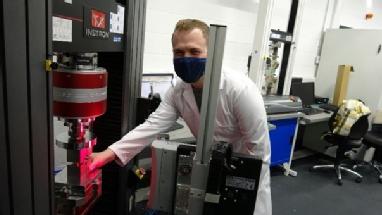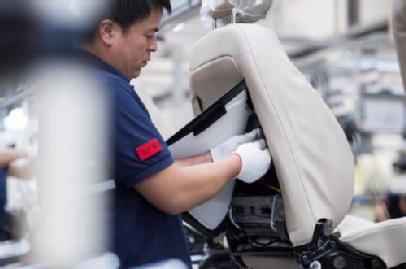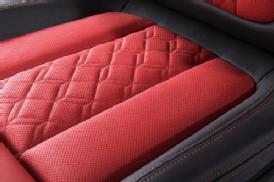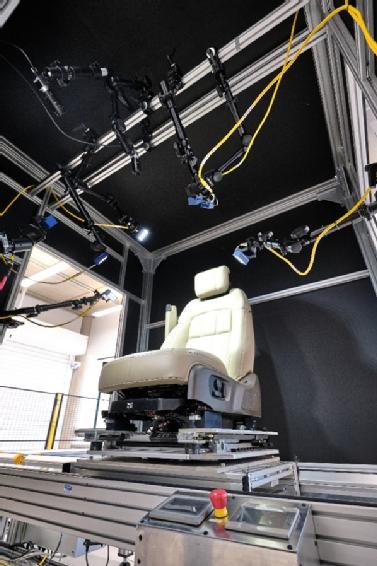Success Story Assetbank
Digital solutions leave seat manufacturer sitting pretty
Car manufacturing in the UK is changing radically, as the electrification is forcing innovation and design change of almost all parts of cars. Industry leaders are challenged to change design radically, launch new products more quickly, while maintaining quality levels and costs. To keep up with this, many manufacturers in the supply chain are already embracing digital technologies to connect their factories, improve processes and reduce costs. By embracing digitalisation, the electrification of the automotive sector could unlock growth of up to £75bn by 2035, benefitting the entire supply chain.
Using digital to develop manufacturing
Lear Corporation are a leading supplier of automotive seats and electrical systems, and their customers include major OEMs such as Jaguar Land Rover. With a long history in luxury and performance seating, they are one of the world’s largest providers of premium automotive leather seats, operating over 250 facilities across 38 countries, including 3 Just in Time final assembly plants here in the UK.

With safety and performance paramount, Lear must ensure that every seat is of the highest quality but working with comfort materials, such as foam, and natural materials, such as leather, brings with it a number of challenges. Not least, the natural defects that occur in these materials, such as wrinkles and discolouration, which must be rectified before products are ready for the customer.

Back in 2017, Andrew Williams, Director, Process Innovation at Lear Corporation was looking for ways to deploy digital technology to improve their seat inspection process, reducing waste and rework. “Seat inspection takes place at the end of the production line, and it’s a manual process which relies on the judgement of experienced operatives,” Andrew said. “But ultimately, it is subjective, we set our standards very high to protect our customer but human judgement will always have an element of variation.”

Lear wanted to innovate and deploy smart manufacturing solutions that would automate the inspection process, providing increased consistency and generating quantitative product data to the engineers in our relentless pursuit of perfect quality. Lear approached WMG as a market study showed a lack of readily available commercial and deployable solution that suited Lear’s needs at that time.
“We already had a relationship with WMG with apprentice, undergraduate and post graduate training programs. Lear’s philosophy is to constantly look for ways to use new technology to improve manufacturing processes and knowing WMG were all about industry-focused research, we knew they would be a good fit for this challenge.”
Andrew teamed up with our Automation Systems Group on the Lear Seat Manufacturing (LSM) project, supported by funding from WMG Centre HVM Catapult.
Exploring the possibilities
After scoping the project carefully, WMG set about building and testing machine learning-based object detection systems as an inspection tool; Using image capture systems mounted on a seat inspection station, the solution would be capable of detecting and classifying defects, and of assessing whether the seat would be acceptable against the customer standards, or whether additional rework is needed.
Developing the solution and training the AI, involved manually labelling a large data set. To facilitate this process, the team developed a “digital marker” that allows an in-line, in-process labelling workflow.
Dr Dan Vera, Associate Professor at WMG, said: “To train the AI inspection system, you need to tell it what defects are and what they look like. You have to label defects so it learns. Typically, labelling is done offline, after images are captured. With the labelling system developed at WMG, operators can digitally label defects on the real seat, and directly on the production line – we call it the magic wand!”
In order to test how the different elements would work together in a real manufacturing environment, we installed a prototype inspection station in the National Automotive Innovation Centre (NAIC) at WMG before taking the station into Lear’s plants for evaluation in production.

Looking to the future
The machine-learning seat inspection software was trialled at two of their factory sites, allowing it to collect data from different types of seat and improve its ability to recognise and categorise all types of defect. It is now on track to deploy across our plants worldwide.
Andrew said that without the help of the team at WMG, supported by funding from HVM Catapult and Innovate UK, they might have missed this opportunity. “This was unchartered territory,” he reflects. “Because this technology was so new, and there were no commercially available solutions at the time, we would not have had the bandwidth to develop this in house. The cumulative effect of these projects has the potential to significantly increase the consistency of our inspection processes and provide our customer with even higher quality products.”
Lear has showcased the test bed in NAIC to some of their key customers, who have been impressed with the outcomes of their work. There is a continued appetite within Lear to develop new ways to use digital technology to improve their manufacturing processes.
For more information about this project, or working with us, please email wmgbusiness@warwick.ac.uk.
